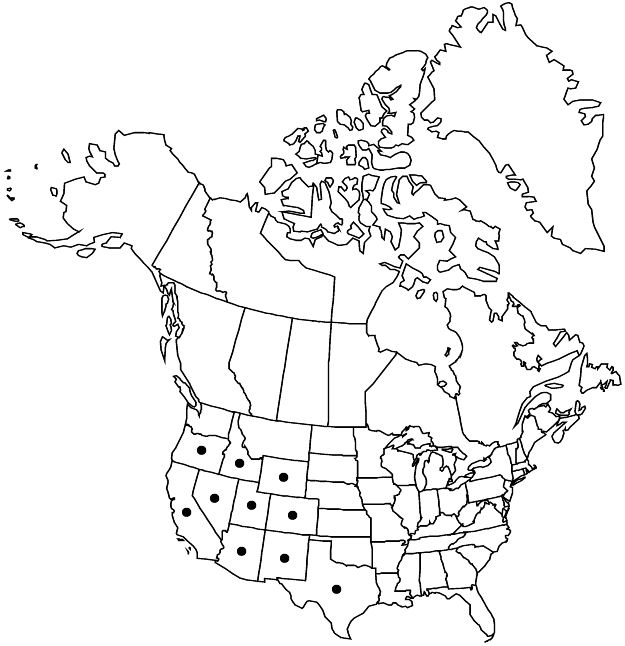Difference between revisions of "Sidalcea neomexicana"
Mem. Amer. Acad. Arts, n. s. 4: 23. 1849.
FNA>Volume Importer |
FNA>Volume Importer |
Revision as of 22:46, 16 December 2019
Herbs, perennial, 0.2–0.8(–1.2) m, glaucous or not, with thick, fleshy, tuberous or fibrous taproot and other roots clustered, fleshy, without caudex and rhizomes. Stems 1–several, clustered, erect or ascending from slightly decumbent base, unbranched or branched, solid, infrequently hollow in robust plants, sometimes glaucous, proximally usually coarsely, densely to moderately bristly-hirsute, hairs often pustulose to sparsely stellate-hairy, sometimes glabrous, distally usually minutely puberulent or glabrous. Leaves basal and cauline, cauline 3+; stipules linear to wide-lanceolate, 4–8 × 1–2 mm; petioles of proximalmost leaves 10–25 cm, reduced distally to shorter than blade, to 5 times blade length; blade fleshy, margins often short-ciliate, surfaces sparsely hairy, less so adaxially, hairs simple-hirsute to stellate, appressed, basal orbiculate, unlobed, margins crenate, or shallowly 5–7(–9)-lobed, (1.5–) 2–6(–8) × (1.5–)2–6(–8) cm, base cordate, apex rounded, lobes with margins crenate to dentate, apex acute, distal cauline highly reduced or not, deeply, palmately (3–)5–7(–9)-lobed, smaller, ultimate divisions linear, margins entire. Inflorescences erect to ascending, open or dense, calyces not conspicuously overlapping except sometimes in bud, unbranched or branched, 20+-flowered, proximal flowers spaced 1+ cm apart, elongate, sometimes 1-sided, 10–25 cm, elongating in fruit; bracts linear to lanceolate, undivided or deeply 2-fid, 4–10 mm, usually equaling or longer than pedicels. Pedicels 5–8(–40) mm, equaling to much longer than calyx in fruit; involucellar bractlets absent. Flowers bisexual or, less frequently, unisexual and pistillate, plants gynodioecious; calyx 5–8(–10) mm, often accrescent, sparsely hairy, hairs simple, to 1 mm, pustulose, sometimes small, stellate, infrequently glandular, surface not obscured; petals pale pinkish rose or pale lavender-purple, bases paler, rarely white, veins usually pale, (6–)10–20(–25) mm, pistillate 8–12 mm, bisexual 18–20 mm; staminal column 5–6 mm, hispid-puberulent; anthers white; stigmas (7 or)8 or 9. Schizocarps 5 mm diam.; mericarps (7 or)8 or 9, 2–3 mm, ± glabrous, sides thin, smooth to slightly reticulate-veined, not pitted, mucro 0.5–0.8(–1) mm. Seeds 1.5 mm. 2n = 20.
Phenology: Flowering (Mar–)Apr–Aug.
Habitat: Desert alkaline springs, moist mountain meadows, wet ditches, marshes
Elevation: 10–2800 m
Distribution

Ariz., Calif., Colo., Idaho, Nev., N.Mex., Oreg., Tex., Utah, Wyo., Mexico (Chihuahua, Coahuila, Durango).
Discussion
Sidalcea neomexicana is variable among and within populations. It is similar to S. covillei and S. sparsifolia, the former possibly derived from it. Sidalcea neomexicana usually can be distinguished by its fleshy roots; hirsute stems; slender pedicels (especially in fruit); pustulate, coarse calyx hairs; and relatively smooth mericarp surfaces. Some plants (in California and Mexico) are well adapted to hot desert springs; overall, S. neomexicana appears to have roots and a rootstock adapted to marshy conditions. It ranges farther south than any other Sidalcea. E. M. F. Roush (1931) recognized no subspecific taxa; C. L. Hitchcock (1957) accepted four geographically and morphologically defined subspecies, three of which (crenulata, neomexicana, thurberi) occur north of Mexico.
Selected References
None.